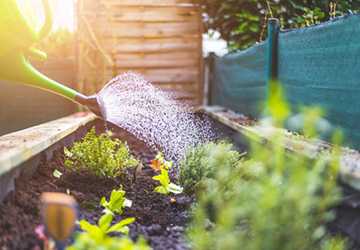A Practical Guide to Urban Farming
Addressing the benefits of urban agriculture can lead to greener, more self-sufficient urban habitats. This urban farming guide is designed to provide aspiring gardeners with the knowledge to transform their urban spaces into lush, productive gardens.
Addressing the benefits of urban agriculture can lead to greener, more self-sufficient urban habitats. This urban farming guide is designed to provide aspiring gardeners with the knowledge to transform their urban spaces into lush, productive gardens.
The nature of urban agriculture
Urban farming is the growing, processing and distributing of food in urban environments. Its growing popularity is driven by a desire to reconnect with our food sources and reduce the environmental impact of conventional farming.

Benefits of Urban Agriculture
● Improving local food supply: Urban farms are critical to improving the supply of local fresh produce.
● Environmentally friendly practices: Growing food locally reduces the need to transport food over long distances, reducing greenhouse gas emissions.
● Promote community connections: Urban green spaces serve as community gathering places, strengthening neighbourhood connections and community well-being.
Entering urban agriculture
For those considering how to start urban farming, here is a customized guide on how to start urban farming:
1. Spatial assessment
● Check your site: identify potential garden sites, whether small balconies, rooftops, or shared community property.
● Light conditions: Identify areas that receive adequate sunlight, essential for plant growth.
2. Crop selection
● Start with the basics: For early success, choose hardy vegetables and herbs like lettuce, spinach, and mint.
● Consider crop cycles: Choose crops with different harvest times to ensure a continuous supply of products.
3. Prepare the soil
● Choose quality soil: Rich, organic soil is the foundation of a healthy garden.
● Watch for gaps: Make enough space between plants to avoid overcrowding.
4. Care and maintenance
● Water evenly: Keep the soil evenly moist and promote plant growth.
● Natural Pest Control: Use environmentally friendly methods to eliminate pests without harming the environment.
Maximize urban garden space
The space constraints of urban environments require creative solutions such as vertical gardens, potted plants and water-saving hydroponic systems.
Creative planting solutions
● Grow plants in a vertical garden: Use wall-mounted planters to grow upwards.
● Potted plant flexibility: Containers are easy to move and manage.
● Water Smart Hydroponics: Save water and space with soilless gardening.
Environmentally conscious urban gardening
Sustainability is the cornerstone of urban agriculture. Practices such as composting food waste, harvesting rainwater and harnessing solar energy contribute to making urban gardens environmentally friendly.
Sustainable gardening practices
● Compost: Turn kitchen scraps into valuable garden compost.
● Rainwater harvesting: Use rain barrels to irrigate your garden sustainably.
● Solar innovation: Integrated solar power system for garden lighting and water pumps.
Community Impact of Urban Agriculture
Urban gardens are not just a source of food; They are platforms for education, community development and the promotion of social justice.
Cultivate community
● Workshops and Learning: Offers educational programs on sustainable living and gardening.
● Shared gardening projects: Encourage communities to participate in gardening projects and strengthen community connections.
Urban construction innovation
Urban construction is undergoing a transformative era with breakthrough technologies leveraging limited urban landscapes to maximize productivity and sustainability.
Aquaponics: Symbiotic Systems
Aquaponics represents a breakthrough fusion of aquaculture and hydroponics, creating a mutually beneficial ecosystem. Here, aquatic organisms secrete nutrients that fertilize plants. In return, the plants purify the water, creating a cycle that saves resources and space.
Bright Garden: Where Technology Meets Nature
The emergence of intelligent gardening integrates technology with traditional cultivation to promote precise plant growth. Sensors monitor soil moisture, solar radiation, and plant nutrition; data is available via smartphone. This technologically sophisticated approach includes automated irrigation and dedicated LED lighting to promote optimal plant health.

Cultivating an Edible Landscape
The concept of edible landscaping revolutionises urban aesthetics and functionality by integrating edible plants into urban landscapes. This move increases visual appeal and contributes to local food supply and environmental sustainability.
Edible ornamental plants
Incorporating beautiful yet edible plants like rainbow chard, purple cabbage, and bright edible flowers creates a combination of functionality and beauty. These plants visually enrich urban gardens while also serving as a source of fresh, nutritious food.
Food forest in a city park
Work with communities to create food forests that transform public spaces into green, efficient ecosystems. Inspired by natural ecosystems, these areas provide a variety of food and serve as educational and recreational spaces that enrich community life.
Urban agriculture is a catalyst for change
Urban development is at the forefront of solving environmental and social problems, from mitigating the heat island effect to improving the mental health of city dwellers.
Green roofs: fighting urban heat
Introducing green roofs in urban buildings is crucial to curb the urban heat island phenomenon. These living roofs provide insulation, reduce energy demand and promote biodiversity in urban environments.
Healing Gardens: Sanctuary in the City
The therapeutic garden design provides city dwellers with a quiet retreat from the hustle and bustle and promotes physical and mental health. These spaces encourage relaxation and community cohesion, thereby contributing to the overall well-being of city residents.
Promote urban agricultural entrepreneurship
Urban agriculture opens the door to innovative business opportunities and turns a passion for gardening into a viable economic venture.
Microgreens: Small plants, big business
Microgreen farming represents a lucrative niche in urban farming. These nutrient-rich crops require little space and mature quickly, making them ideal for urban farmers exploring business opportunities.
Urban Agriculture Workshops and Tours
By hosting workshops and tours, urban farmers can share their expertise and passion and educate communities on the importance of sustainable practices and local food systems. This spread knowledge and inspired a new wave of urban farmers.
Looking Ahead: The Future of Urban Agriculture
Given the increasing urban population, it is increasingly essential to integrate agriculture into urban planning. Technological advances, community engagement and environmentally friendly practices are shaping the development of urban agriculture, making it a necessary part of city life.
Diploma
Entering urban farming is a journey toward sustainability, self-sufficiency, and community enrichment. This guide to urban farming serves as a guide to understanding its benefits and getting started. Transforming urban spaces into productive gardens nourishes the body, soul, and community.
As you embark on your green journey, remember that each season offers new lessons and opportunities for growth. Embrace the challenges and joys of urban gardening and help your urban oasis thrive by showcasing the resilience and ingenuity of urban farmers.